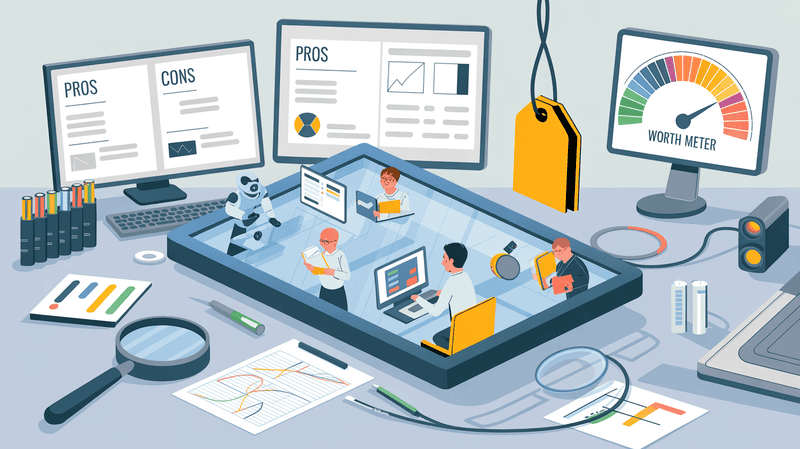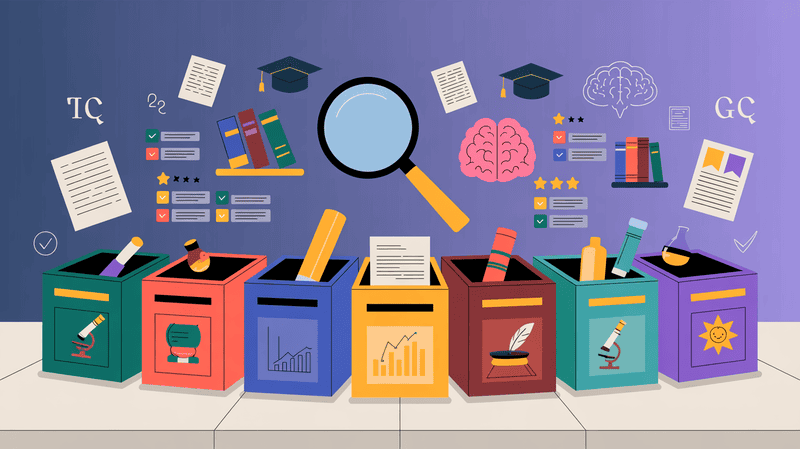Many people are excited about the new AI models of GPT and Claude, but they're often hard to use or understand. Big tech companies usually keep their AI secret. This means only a few companies control powerful AI. Most people can't learn from or improve these models. This slows down progress and makes AI less fair for everyone.
Apple has just released a new AI model called DCLM that anyone can use. There are two versions: a big one and a smaller one. The big model works really well, even better than some famous AI models. By sharing these models, Apple is helping more people learn about and use AI. This could lead to faster progress and better AI for everyone.
Let's know more about this new model of Apple.
What is the new Apple Open Source AI Model?
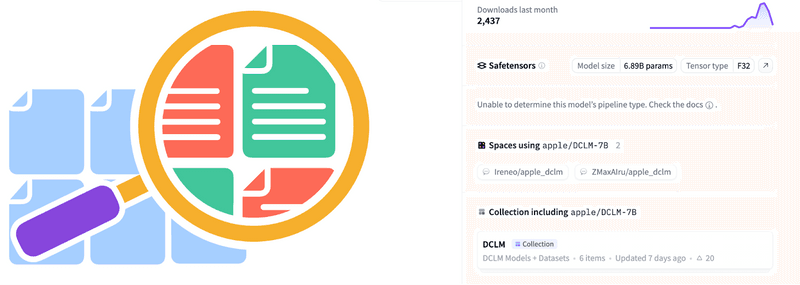
Apple recently released a new artificial intelligence (AI) model that anyone can use for free. This model is called DCLM-7B, and it's part of Apple's efforts to contribute to the AI community.
Key points about the new Apple AI model:
It's open-source: This means anyone can access, use, and even modify the model for their own projects.
Size: The main model has 7 billion parameters. There's also a smaller version with 1.4 billion parameters.
Performance: It works very well compared to other AI models of similar size. In some tests, it performs better than models from other well-known companies.
Efficiency: The model achieves good results while using less computing power for training than some other models.
Transparency: Apple has shared not just the model, but also the training code and the data used to create it. This is unusual and very helpful for researchers.
Not for Apple products: While Apple created this model, it's not meant for iPhones or other Apple devices. It's mainly for research and development in the AI field.
Collaboration: Apple worked with researchers from universities and other companies to develop this model.
This new AI model shows that Apple is committed to advancing AI technology in an open and collaborative way. By making it freely available, while it may not directly affect most Apple users, this work could lead to better AI features in various technologies in the future.
What are DCLM Models?

DCLM Models, which stands for DataComp for Language Models, are new artificial intelligence (AI) models created by Apple in collaboration with researchers from universities and other companies. These models are part of a larger project called DataComp, which aims to find the best ways to choose data for training AI models.
The DataComp project is unique because it uses the same setup for all experiments. This means they use the same computer code, testing methods, and ways of measuring success. By doing this, they can focus on how different data strategies affect the final AI model. This approach has led to the creation of two main DCLM models: a large one with 7 billion parameters (DCLM-7B) and a smaller one with 1.4 billion parameters (DCLM-1.4B).
Let's look at the technical details of DCLM models:
DCLM-7B:
Trained on 2.5 trillion tokens of text data
Has a context window of 2,000 tokens (can work with about 2,000 words at a time)
Scored 63.7% on the MMLU test, a benchmark for measuring AI intelligence
Outperforms Mistral-7B (62.7%) and is close to larger models like Llama3 8B (66.2%) and Gemma (64.3%)
Uses 40% less computing power for training compared to previous models
DCLM-1.4B:
Trained on 2.6 trillion tokens, jointly with Toyota Research Institute
Scored 41.9% on the MMLU test
Outperforms other small models like SmolLM 1.7B (39.97%), Qwen-1.5B (37.87%), and Phi-1.5B (35.90%)
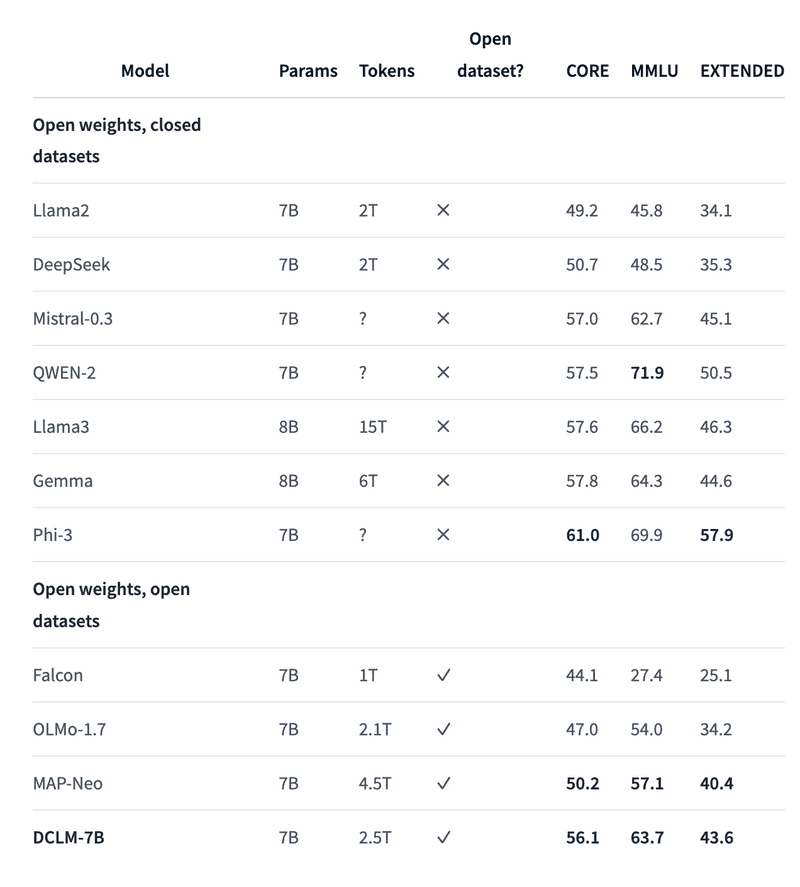
The researchers didn't stop there. They further improved the DCLM-7B model by extending its context length to 8,000 tokens. They did this by training it for an additional 100 billion tokens using a technique called Dataset Decomposition. This improved the model's performance on a wide range of tasks, including tests called HellaSwag and ARC-E.
When compared to other models, DCLM-7B stands out for its efficiency. It performs better than MAP-Neo, which was previously considered the best in the open-data language model category. What's more, DCLM-7B achieves this while using 40% less computing power for training. This efficiency is a big deal in AI research, as it could lead to more affordable and accessible AI tools in the future.
The DCLM models are currently available under different licenses. The larger 7B model is released under Apple's Sample Code License, while the smaller 1.4B version is available under the Apache 2.0 license. The Apache 2.0 license is particularly significant as it allows for commercial use, distribution, and modification of the model.
Why is Data Curation Important in AI Models?
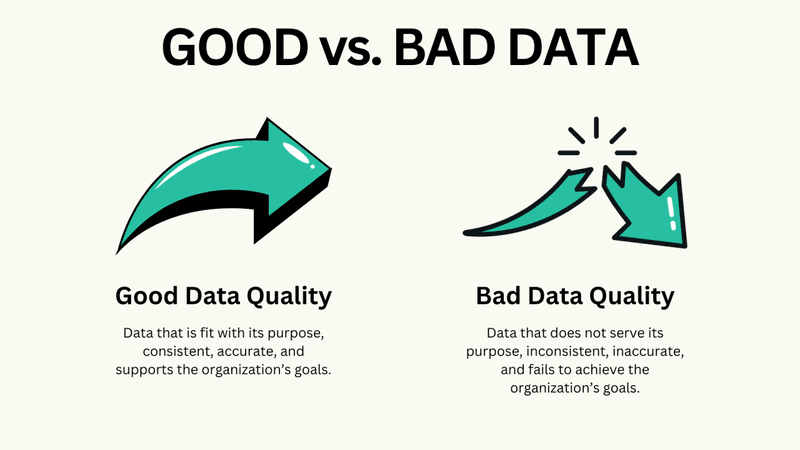
Image Credit: Edgedelta
Data curation is the process of choosing and organizing the information used to train AI models. It's like picking the best ingredients for a recipe. Here's why it's so important:
Better Performance Good data helps AI models work better. Apple's DCLM-7B model shows this clearly. It performs almost as well as bigger models but uses less computer power. This is largely because of smart data choices.
Efficiency With well-curated data, AI models can learn more from less information. The DCLM-7B model, for example, was trained on 2.5 trillion pieces of text (called tokens) but performs similarly to models trained on much more data.
Reducing Biases Careful data selection can help reduce unfair biases in AI models. By choosing a wide range of good-quality data, we can create models that are fairer and more accurate for everyone.
Saving Resources Training AI models uses a lot of computer power and electricity. Better data means we can create good models with less training, saving energy and money.
Faster Development With the right data, researchers can create useful AI models more quickly. This speeds up AI research and development.
Improved Safety Well-curated data can help make AI models safer. It reduces the chance of the model learning harmful or incorrect information.
Specialized Knowledge Curated data can help AI models learn specific topics better. This is useful for creating AI that's good at particular tasks or fields.
Note: In the DCLM project, researchers used "model-based filtering." This means they used AI to automatically choose high-quality data from larger datasets. This method proved very effective in creating powerful, efficient models.
What Will the Future of Apple AI Models be?
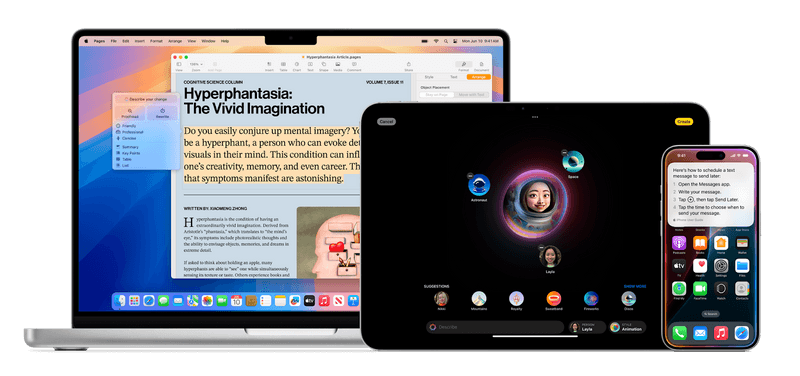
Apple may have been a late starter in the AI race, but their recent DCLM models show they're quickly gaining ground. These open-source models, with 7 billion and 1.4 billion parameters, are performing impressively on benchmarks. In fact, the larger model is outperforming some well-known competitors like Mistral-7B and is close behind industry leaders such as Llama 3 and Gemma.
Here's what we might expect with this fast progress of Apple in AI Race:
More Open-Source Releases
Apple seems to be following Meta's strategy of releasing open-source AI models.
This approach could boost Apple's reputation in the AI community and speed up their progress.
We might see a growing family of Apple AI models available to researchers and developers.
Efficient AI Development Apple's success with DCLM models shows they can create powerful AI using less data and computing power. This efficiency could lead to:
Faster development of new AI models
AI that works well on devices with less powerful chips
More environmentally friendly AI that uses less energy
As Apple refines its AI capabilities, we're likely to see more AI features built into Apple devices:
Siri could become much smarter, handling more complex tasks
We might get AI-powered photo and video editing tools right on our iPhones
Real-time language translation could improve significantly
Apple's ecosystem is known for its seamless integration, and future AI developments could enhance this further:
AI might help devices understand user habits across all Apple products
We could see AI experiences that flow smoothly from Apple Watch to Mac
Privacy features might improve using on-device AI
While Apple is making strides, they're still catching up to AI giants like OpenAI (ChatGPT), Anthropic (Claude), and Google (Gemini). However, if their progress continues at this pace, we might soon see Apple AI ( Apple Intelligence ) that can:
Understand and respond to complex questions
Generate human-like text and engage in sophisticated conversations
Compete directly with top AI assistants
In the future, Apple might revolutionize how we use our devices, making them smarter and more helpful in our daily lives. As Apple continues to develop its AI capabilities, it might not be long before they're competing head-to-head with the current leaders in AI technology.
Conclusion
To wrap up, Apple's new DCLM AI models are a big deal. They show that Apple is serious about AI and wants to help everyone learn more about it. By sharing these models, Apple is doing something different from other big tech companies. This could lead to more people working on AI and making it better for everyone.
The DCLM models are pretty impressive. They work really well and don't need as much computer power as other models. This could mean we'll see more AI in our everyday devices soon. Maybe Siri will get a lot smarter, or we'll have cool new AI tools on our phones.
While Apple is still behind some other AI companies, they're catching up fast. If they keep going like this, we might soon see Apple AI that can do amazing things. It's exciting to think about how this could change the way we use our devices and make our lives easier.
FAQs
1. What type of AI does Apple use?
Apple uses generative AI combined with personal context in their products. They're developing custom chips for AI in data centers and employing advanced algorithms in iPhones for features like computational photography, aiming to deliver personalized, helpful intelligence across their ecosystem.
2. Is Apple working on their own AI?
Yes, Apple is actively developing its own AI technology. They're creating custom chips for data centers (Project ACDC) and integrating AI into their products. Tim Cook has emphasized Apple's unique approach to AI, combining generative capabilities with personal context for enhanced user experiences.
3. Does Apple use AI for photos?
Apple extensively uses AI for photography in iPhones. Their computational photography techniques rely on advanced algorithms and AI to power features like Portrait Mode. This technology enables the iPhone to identify subjects, create bokeh effects, and enhance image quality across various shooting conditions.


